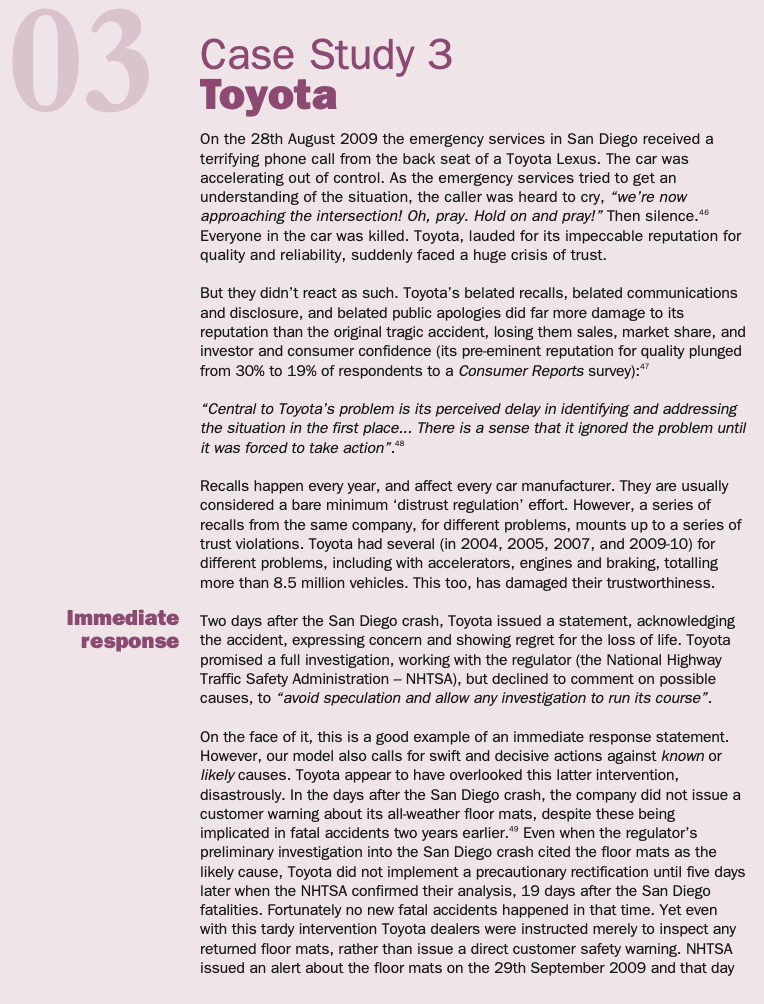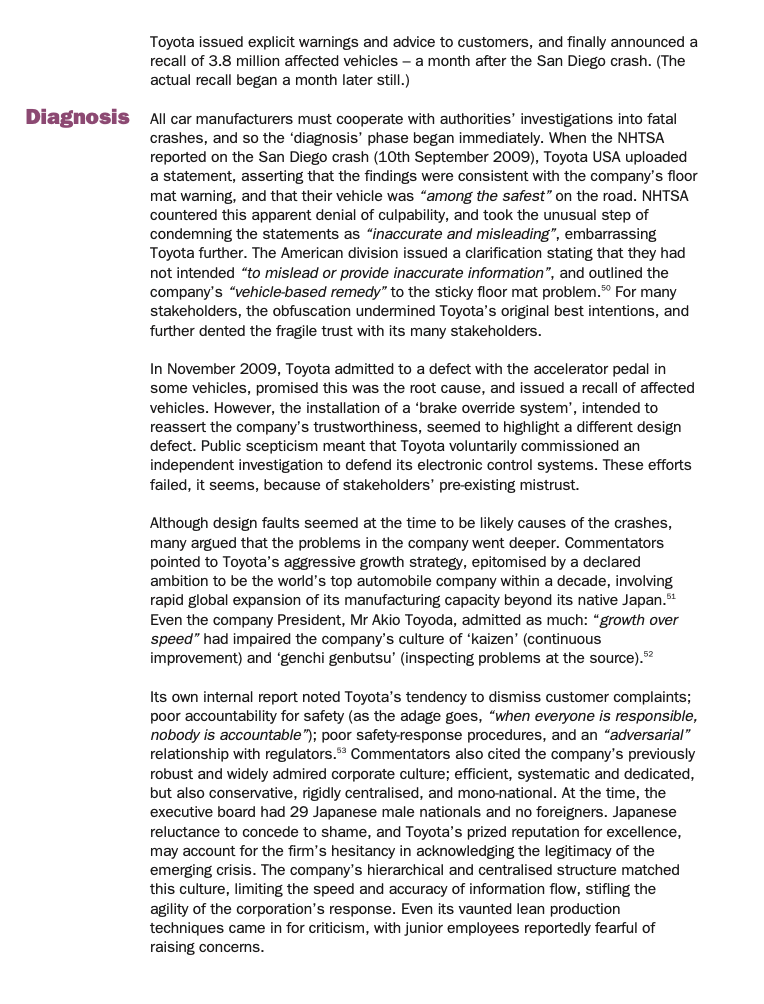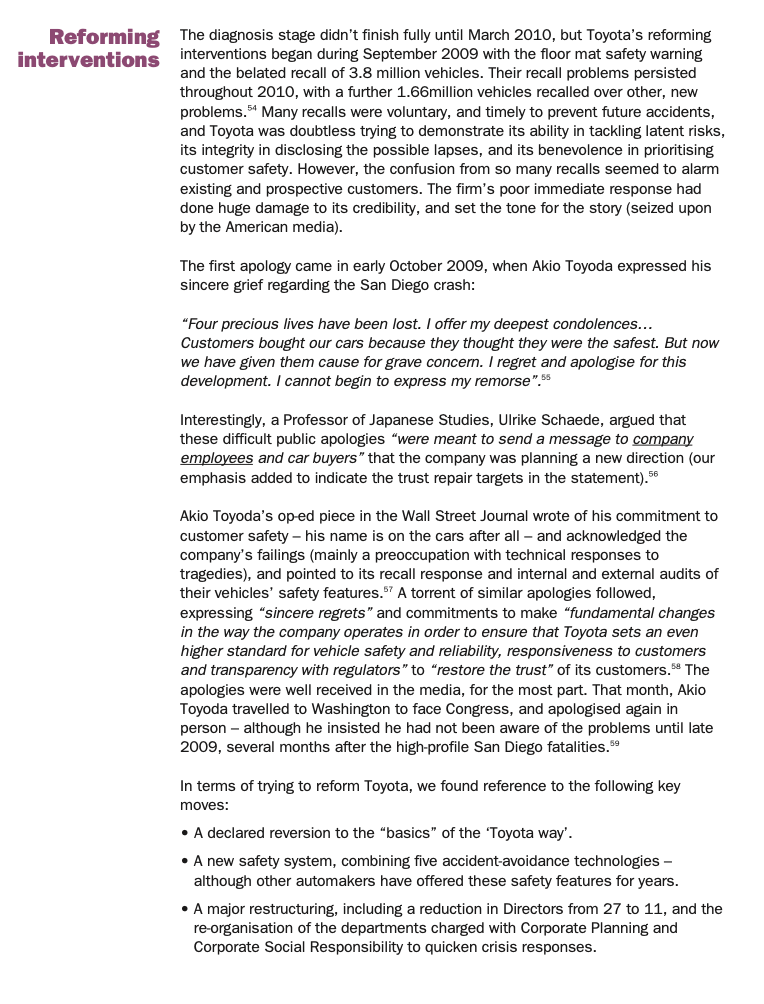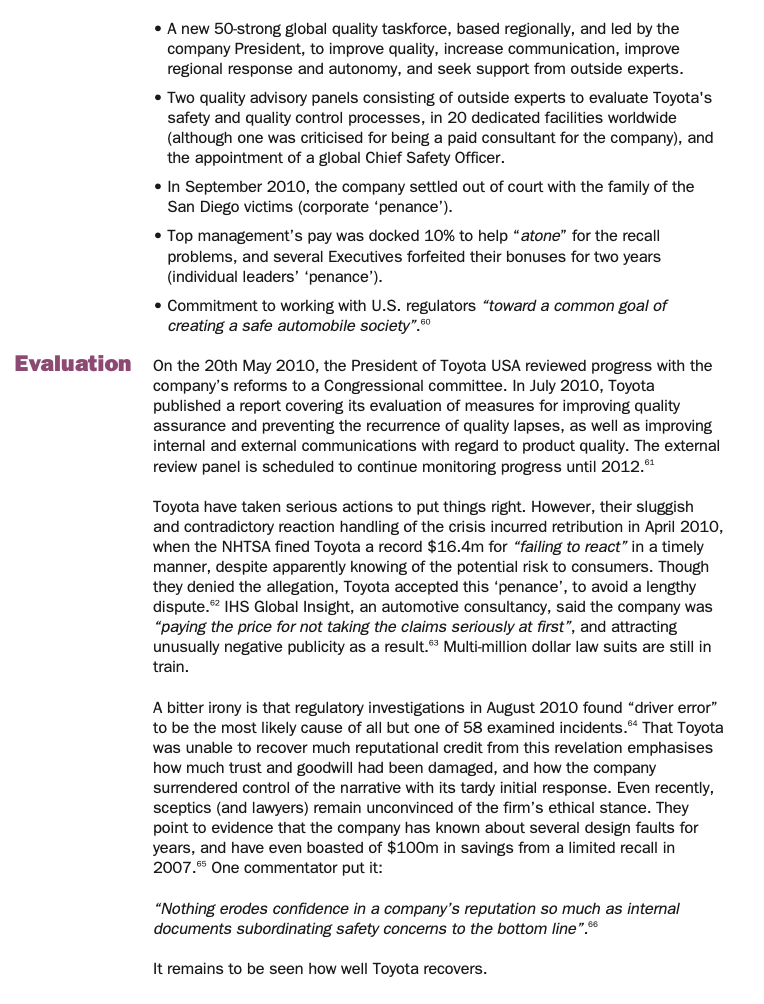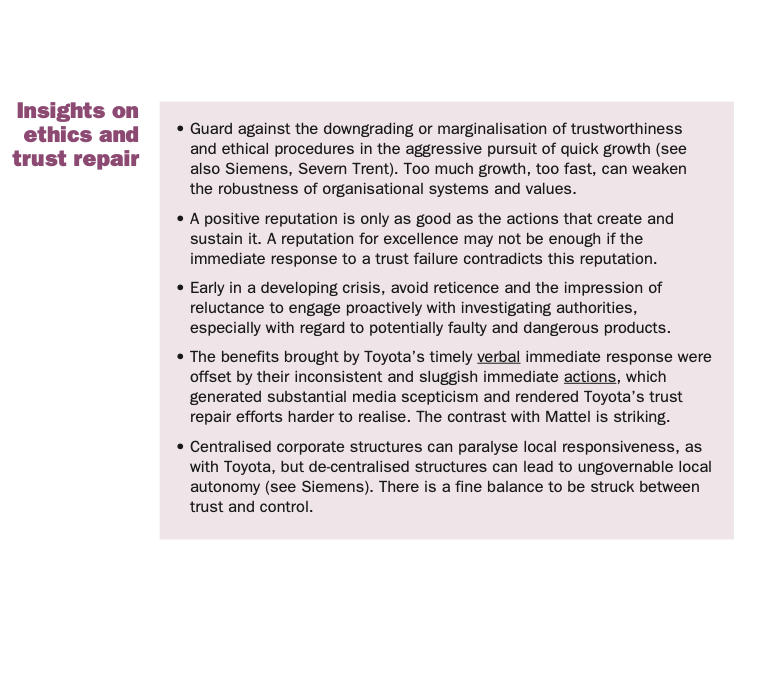Relative to the business case you have selected (Toyota), what affective-dominant trust building (or rebuilding) activities has the company engaged-in to build (or rebuild) the trust with their customers?
Select two affective-dominant trust building (or rebuilding) activities they have engaged-in that feature in the business case and describe if they been effective, or not, in your opinion?
Specific to two types of customer, what are two additional affective-dominant selling activities or interactions that would serve to further build (or rebuild) trust with the following customer types after the breach of trust described in the business case you have selected (select the appropriate customer types based on your case selection), based on your understanding of overcoming fears and objections with buyers
Immediate response Case Study 3 Toyota 0n the 28111 August 2009 the emergency services in San Diego received a terril'ying phone call from the back seat of a Toyota Lexus. The car was accelerating out of control. As the emergency services tried to get an understanding of the situation, the caller was heard to cry, \"we're now approaching the intersection! Oh. pray. Hold on and pray!\" Then silence.\" Everyone in the car was killed. Toyota. lauded for its impeccable reputation for quality and reliability. suddenly faced a huge crisis of trust. But they didn't react as such. Toyota's belated recalls. belated communications and disclosure. and belated public apologies did far more damage to its reputation than the original tragic accident. losing them sales, market share. and inmstor and consumer condence {its pre-eminent reputation for quality plunged from 30% to 19% of respondents to a Consumer Reports sunrey)?\" \"Central to Toyota '5 problem is its perceived delay in identiring and addressing the situation in the rst place... There is a sense that it ignored the problem until it was forced to take action'.\" Recalls happen every year. and affect every car manufacturer. They are usually considered a bare minimum 'distrust regulation' effort. However, a series of recalls from the same company, for different problems. mounts up to a series of trust violations. Toyota had several (in 2004, 2005, 2007. and 2009-10] for different problems, including with accelerators. engines and braking. totalling more than 8.5 million vehicles. This too, has damaged their trustworthiness. Two days after the San Diego crash, Toyota issued a statement. acknowledging the accident, expressing concern and showing regret for the loss of life. Toyota promised a full investigation. working with the regulator (the National Highway Trafc Safety Administration NHTSA}, but declined to comment on possible causes. to 'avoid speculation and aliow any investigation to run its course\". On the face of it. this is a good example of an immediate response statement. However. our model also calls for swift and decisive actions against known or likely causes. Toyota appear to have overlooked this latter intervention. disastrously. In the days after the San Diego crash, the company did not issue a customer warning about its all-weather oor mats. despite these being implicated in fatal accidents two years earlier.\"I Even when the regulator's preliminary investigation into the San Diego crash cited the floor mats as the likely cause. Toyota did not implement a precautionary rectication until ve days later when the NHTSA conrmed their analysis, 19 days after the San Diego fatalities. Fortunately no new fatal accidents happened in that time. Yet even with this tardy intervention Toyota dealers were instnrcted merely to inspect any returned floor mats. rather than issue a direct customer safety warning. NHTSA issued an alert about the floor mats on the 29th September 2009 and that day Diagnosis Toyota issued explicit warnings and advice to customers. and nally announced a recall of 3.8 million affected vehicles a month after the San Diego crash. [The actual recall began a month later still.) All car manufacturers must cooperate with authorities' investigations into fatal crashes. and so the 'diagnosis' phase began immediately. When the NHTSA reported on the San Diego crash (10th September 2009]. Toyota USA uploaded a statement. asserting that the ndings were consistent with the company's oor mat warning, and that their vehicle was \"among the safest\" on the road. NHTSA countered this apparent denial of culpability. and took the unusual step of condemning the statements as "inaccurate and misleading". embarrassing Toyota further. The American division issued a clarification stating that they had not intended \"to mislead orprtm'de inaccurate infomation ", and outlined the company's \"vehicle-based remeoy" to the sticky floor mat problem.50 For many stakeholders. the obfuscation undermined Toyota's original best intentions. and further dented the fragile trust with its many stakeholders. In November 2009. Toyota admitted to a defect with the accelerator pedal in some vehicles. promised this was the root cause, and issued a recall of affected vehicles. However. the installation of a 'brake override system'. intended to reassert the company's trustworthiness. seemed to highlight a different design defect. Public scepticism meant that Toyota voluntarily commissioned an independent investigation to defend its electronic control systems. These efforts failed. it seems. because of stakeholders' pro-existing mistrust. Although design faults see med atthe time to be likely causes of the crashes. many argued that the problems in the company went deeper. Commentators pointed to Toyota's aggressive growth strategy. epitomised by a declared ambition to be the world's top automobile company within a decade. involving rapid global expansion of its manufacturing capacity beyond its native Japan.\" Even the company President, Mr Akio Toyoda. admitted as much: "youth over speed\" had impaired the company's culture of 'kaizen' (continuous improvement) and 'genchi genbutsu' [inspecting problems at the source).52 Its own internal report noted Toyota's tendency to dismiss customer complaints: poor accountability for safety [as the adage goes, \"when everyone is responsible. nobody is accountable '): poor safetyresponse procedures, and an \"adversariai' relationship with regulators.\"a Commentators also cited the company's previously robust and widely admired corporate culture; efficient, systematic and dedicated, but also conservative, rigidly centralised, and mono-national. At the time. the executive board had 29 Japanese male nationals and no foreigners. Japanese reluctance to concede to shame, and Toyota's prized reputation for excellence, may account for the rm's hesitancy in acknowledging the legitimacy of the emerging crisis. The company's hierarchical and centralised structure matched this cuiture. limiting the speed and accuracy of information ow. stiing the agility of the corporation's response. Even its vaunted lean production techniques came in for criticism, with junior employees reportedly fearful of raising concerns. Reforming illtBIVOlltiOI'IS The diagnosis stage didn't nish fully until March 2010. but Toyota's reforming interventions began during September 2009 with the oor mat safety warning and the belated recall of 3.8 million vehicles. Their recall problems persisted throughout 2010. with a further 1.66million vehicles recalled over other. new problems.\" Many recalls were voluntary. and timely to prevent future accidents. and Toyota was doubtless trying to demonstrate its ability in tackling latent risks. its integrity in disclosing the possible lapsesI and its benevolence in prioritising customer safety. However. the confusion from so many recalls seemed to alarm existing and prospective customers. The firm's poor immediate response had done huge damage to its credibility. and set the tone for the story (seized upon by the American media]. The rst apology came in early October 2009. when Akio Toyoda expressed his sincere grief regarding the San Diego crash: \"Four precious lives have been lost. i offer my deepest condolences... Customers bought our cars because they thought they were the safest. But now we havegfven them cause forgrave concern. lreyet and apologise for this development. i cannot begin to express my remorse '1\" Interestingly. a Professor of Japanese Studies. Ulrike Schaede. argued that these difficult public apologies \"were meant to send a message to company emglos and car buyers" that the company was planning a new direction (our emphasis added to indicate the trust repair targets in the statement}?a Akio Toyoda's op-ed piece in the Wall Street Journal wrote of his commitment to customer safety- his name is on the cars after all and acknowledged the company's failings (mainly a preoccupation with technical responses to tragedies), and pointed to its recall response and internal and external audits of their vehicles' safety features." A torrent of similar apologies followed, expressing \"sincere regrets\" and commitments to make \"l'undamental changes in the way the company operates in order to ensure that Toyota sets an even higher standard for vehicle safety and reliability, responsiveness to customers and transparency with regulators " to \"restore the trust" of its customers.53 The apologies were well received in the media. for the most part. That monthI Akio Toyoda travelled to Washington to face Congress, and apologised again in person although he insisted he had not been aware of the problems until late 2009. several months after the high-prole San Diego fatalities.\"a In terms of trying to reform ToyotaI we found reference to the following key moves: II A declared reversion to the \"basics\" of the 'Toyota way'. II A new safety system, combining ve accident-avoidance technologies although other automakers have offered these safety features for years. II A major restructuring. including a reduction in Directors from 27 to 11. and the re-organisation of the departments charged with Corporate Planning and Corporate Social Responsibility to quicken crisis responses. Evaluation - A new 50-strong global quality taskforce, based regionally, and led by the company President, to Improve quality, Increase communication, improve regional response and autonomy, and seek support from outside experts. - Two quality advisory panels consisting of outside experts to evaluate Toyota's safety and quality control processes, In 20 dedicated facilities worldwide (although one was criticised for being a paid consultant for the company], and the appointment of a global Chief Safety Ofcer. - In September 2010. the company settled out of court with the family of the San Diego victims {corporate 'penance'). - Top management's pay was docked 10% to help \"atone" for the recall problems, and several Executives forfeited their bonuses for two years (Individual leaders' 'penance'i. - Commitment to working with U.S. regulators \"toward a common goal of creating a safe automobile society.\" 0n the 20th May 2010, the President of Toyota USA reviewed progress with the company's reforms to a Congressional committee. In July 2010, Toyota published a report covering its evaluation of measures for improving quality assurance and preventing the recurrence of quality lapses, as well as improving lntemal and external communications with regard to product quality. The external review panel ls scheduled to continue monitoring progress until 2012.\"u Toyota have taken serious actions to put things right. However, their sluggish and contradictory reaction handling of the crisis incurred retribution In April 2010, when the NHTSA fined Toyota a record $16.4m for \"falling to react\" in a timely manner. despite apparently knowing of the potential risk to consumers. Though they denied the allegation, Toyota accepted this 'penance', to avoid a lengthy dispute.62 IHS Global Insight, an automotive consultancy, said the company was \"paying the price for not taking the claims seriously at first\Insights on ethics and . Guard against the downgrading or marginalisation of trustworthiness trust repair and ethical procedures in the aggressive pursuit of quick growth (see also Siemens, Severn Trent). Too much growth, too fast, can weaken the robustness of organisational systems and values. . A positive reputation is only as good as the actions that create and sustain it. A reputation for excellence may not be enough if the immediate response to a trust failure contradicts this reputation. . Early in a developing crisis, avoid reticence and the impression of reluctance to engage proactively with investigating authorities, especially with regard to potentially faulty and dangerous products. . The benefits brought by Toyota's timely verbal immediate response were offset by their inconsistent and sluggish immediate actions, which generated substantial media scepticism and rendered Toyota's trust repair efforts harder to realise. The contrast with Mattel is striking. . Centralised corporate structures can paralyse local responsiveness, as with Toyota, but de-centralised structures can lead to ungovernable local autonomy (see Siemens). There is a fine balance to be struck between trust and control
